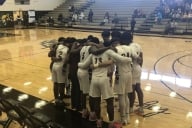You have /5 articles left.
Sign up for a free account or log in.
The 65 members of the wealthiest National Collegiate Athletic Association conferences will finally test their increased legislative powers this week, as they use a new level of autonomy to vote on a number of proposals giving more support and benefits to college athletes when the association meets on the outskirts of Washington, D.C.
In August, the Division I Board of Directors gave the "Power Five" leagues -- the Atlantic Coast, Big Ten, Big 12, Pacific 12, and Southeastern Conferences -- the ability to make their own rules concerning a range of issues. When facing a Senate committee during a hearing in July, Mark Emmert, the NCAA's president, suggested that the new governance structure would allow the wealthiest NCAA members to finally adopt several long-discussed changes to association rules, including allowing full-cost-of-attendance stipends, offering four-year scholarships, and providing better health care for athletes.
Many of those proposals will indeed be on the table this week during the legislative sessions at the convention.
The five conferences will consider proposals that would allow all Division I institutions to offer aid that covers an athlete's full cost of attendance, to provide comprehensive medical support, and to increase academic services. They will also consider legislation that would give athletes greater flexibility to buy insurance protecting the value of their future earnings against injury, create new concussion management requirements, and regulate time demands to "ensure an appropriate balance between athletics participation and academic obligations."
Nathan Hatch, chair of the Division I Board of Directors and president of Wake Forest University, said in a statement that he hoped voting on these issues autonomously would "not only allow the membership to focus more intently on the well-being of our student-athletes, but to also preserve the tradition of Division I as a diverse and inclusive group of schools competing together on college athletics’ biggest stage.”
A Rocky Road?
The change in governance has been criticized by a number of Division I leaders, who worried that the autonomous proposals would fuel a growing stratification of college sports and create a bigger divide between the haves and the have-nots. Heading into this year’s convention, anxiety still exists about the state of Division I athletics and how the division is organized. This is particularly true among those institutions outside of the Power Five conferences, but there is also potential for friction within the autonomous leagues.
In October, Kirk Schulz, the president of Big 12 member Kansas State University, said that while he supports autonomy, he doesn’t think the voting process “is going to go as smooth as everyone thinks it is.”
“The $120 million programs are going to have a different perspective than the $50 million programs," Schulz said. "I think we’re in for a rocky road. We also have to realize and continue to realize that we all live in a big tent together and we have to make sure the rest of Division I feels good with what we're doing. We can't have a big stick, start waving it around, and then wonder why everyone’s pissed off."
The Knight Commission released a study last week -- timed to generate conversation ahead of the convention – detailing a survey that found that about one-third of Division I athletics administrators, faculty, and coaches anticipate a decrease in the number of athletics scholarships over the next five years because of the current legal and financial climate.
Many respondents to the survey, which included participants from 55 Division I institutions, said they were especially concerned about funding the “autonomy initiatives.” Institutions outside of the autonomous conferences will not be required to adopt those proposals, but many worry they must do so anyway in order to remain competitive. “There is a clear indication that many respondents are not particularly confident about funding new initiatives for football and basketball athletes, and are indeed skeptical about paying for these enhancements for athletes in other sports,” the authors wrote.
Critics like Gerald Gurney, president of the Drake Group and former president of the National Association of Academic Advisors for Athletics, also remain skeptical. Gurney said that, as the changes will only be adopted by a small number of Division I schools, he doesn't believe the autonomy proposals will result in systemic change. The legislation, he said, also doesn't touch on larger issues such as academic integrity and control of football playoff revenue.
"The autonomous vote is not the key," he said. "While they may be able to offer more benefits to their student athletes, the Power Five schools are literally bankrupting the other conferences."
Last month, the board of directors of the Football Bowl Subdivision's Faculty Athletics Representatives group released a statement criticizing the lack of faculty presence in the recently reorganized Division I council. The new makeup grants 27 of the 32 council seats to athletics directors, but only one to faculty representatives.
"Is this an appropriate configuration for the chief policy‐setting body for Division I?" the board asked. "Does it reflect a commitment to the collegiate model? If academic values are to have significant relevance in intercollegiate athletics, it strikes us as inconsistent to include only minor representation by faculty."
Division II
The current pressure the NCAA is under to provide more support for athletes can also be seen in some of Division II’s proposals this year. The restructuring of the Division I Board of Directors last year --- the same reorganizing that granted autonomy to the Power Five -- resulted in increased athlete representation. Division II now hopes to do the same with its own management council.
The proposal, which would be effective immediately, creates two council seats for athlete representatives. The seats would go to two members of the Student-Athlete Advisory Committee, and would grant them one combined vote on the 27-seat council.
The division will also consider legislation that would let institutions provide meals and snacks to all scholarship and non-scholarship athletes at its discretion and to be permitted to provide “actual and necessary expenses” for athletes during travel to both competitive and non-competitive events, such as media appearances and goodwill tours.
Another proposal would eliminate any impact on an athlete’s eligibility if he or she is involved in impermissible recruiting contact with an institution. The violations would remain institutional, but would not be applicable to the student. “The prospective student-athletes lack involvement and culpability in these cases,” the proposal states.
Legislation that bars coaches from serving as an institution’s compliance administrator, eliminating potential conflict of interests, will be considered, too. The new requirement, which would go into effect in 2018, applies to institutions hoping to become a member of the division, but not to those who are already members.
The proposal notes, however, that the “overwhelming majority” of Division II institutions follow this rule and the change would just codify what’s already considered common practice.
Division III
The NCAA’s largest division -- and the only one that does not offer athletic scholarships -- will mostly discuss new recruiting proposals at this year’s convention. That’s been a primary focus of the division during legislative sessions for a number of years now, and this year’s proposed legislation offers no less than five different suggestions regarding recruitment.
The proposals include permitting coaching staff members to contact prospective athletes on days of competition, to let recruiters make in-person contact with athletes after they have completed their sophomore year of high school, and to allow on-campus evaluations of prospective athletes. The division will also consider legislation about budget management and adjusting practice seasons, said Alan Cureton, president of the University of Northwestern at St Paul and chair of the Division I presidents council.
Unlike Division II, there’s little in Division III’s proposals that reflect the broader concerns felt within Division I and NCAA leadership. Cureton said that’s because Division III's members don't face many of the issues that fuel headlines, lawsuits, and power struggles in more mainstream college athletics. “Even though the institutions are diverse in size, mission, geography, or programs, there exists a strong sense of unity within the membership,” Cureton said.
In 2008, just as the Power Five have threatened to do in Division I, Division III nearly split in two. The possibility revealed a number of divergent opinions concerning supposedly concrete philosophies among the members. With 442 institutions, Division III is still full of differing viewpoints, Cureton said, but he now sees this more as a healthy debate among the membership.
"Quite honestly, the support to stay as is was so strong that the final vote overwhelmingly reflected the view of the membership, which was to stay as one division," Cureton said. "For the past several years, this topic has not re-surfaced. I do not see it resurfacing for a long time, if ever."








